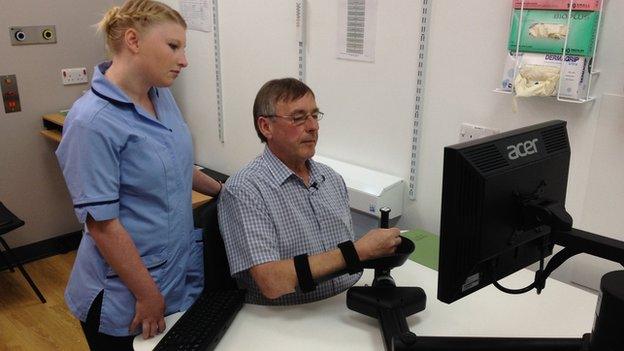'Robot revolution' in stroke care promised
- Published

Anne Hopwood having physio after a stroke
Intensive physiotherapy is the traditional way to treat the 110,000 people who have a stroke in the UK every year.
That's what Anne Hopwood is doing as she slowly moves her right arm back and forth across a table, guided gently by her physio.
She lost movement on the right side of her body when she fell ill last November.
The repetitive exercises are designed to get the brain and arm to communicate again after being damaged by the stroke.
But Anne knows rehab is a long haul.
"It was bad when I first had it," she says.
"Now I can walk with [husband] Peter in the house, up and down the steps, I couldn't do that before."
But just down the corridor from where Anne is having her physiotherapy at North Tyneside Hospital, a piece of cutting-edge technology offers the prospect of a revolution in stroke rehabilitation.
Here another stroke patient, Tom Means, a 61-year-old electrician, is working with a state-of-the-art robot.

His right arm, damaged by a stroke in March, is strapped on to a robotic limb, which he grips with his fist.
Through moving his own damaged arm, Tom is trying make a cursor hit targets on a computer screen.
Again, in trying to hit the targets, he's practising repetitive movements.
'Big help'
But the robot can accurately gauge how much movement he has and how strong his arm is becoming, it's all helping Tom back to an independent life.
"When you've had a stroke, every bit of exercise and movement you can do is a big help," he says.
"Using the robot alongside my other exercises is ideal for me and what's great about the robot is that it also helps my hand-eye co-ordination.
"I've only had a few sessions so far. However, I've really felt the difference in my arm as I've got a lot more movement and much more strength.
"I'm under no illusions that it's going to be a lot of hard work, but it's all worthwhile because I know it's going to make me better."
The technology has already proved its worth in the United States.

Brain scan of a stroke
Now for the first time it is being tested in the UK as part of a five-year trial, at North Tyneside in collaboration with Newcastle University, as well as three other centres in Romford, Cambridge and Glasgow.
Helen Rodgers, a professor of stroke care at the Institute for Ageing and Health at Newcastle University and a consultant stroke physician at Northumbria Healthcare NHS Foundation Trust, is leading the research.
She says: "We have been looking at the research undertaken in the USA, and we are working closely with colleagues at the Massachusetts Institute of Technology to see if robot-assisted training is an effective treatment.
"If shown to be effective, robot-assisted training has the potential to change how we provide NHS rehabilitation for people with arm weakness due to stroke."
Optimum movement
Dr Hermano Igo Krebs, a principal research scientist at MIT, has pioneered the robot technology.
"The whole concept is revolutionising the practice of rehabilitation medicine by applying robotics that can assist and enhance recovery," he says.
"Our focus is on helping clinicians to facilitate a functional recovery for their patients by using intensive and highly interactive robotic therapy to help people achieve their absolute optimum movement."
Up to 85% of all stroke patients will be left with restricted movement in the arm, so Dr Shamim Quadir, of the Stroke Association, is excited by the prospects for improved treatment opened up by the rehab robot.
"The advantage of having this type of robot-assisted training means that everything is recorded on a computer," he says.
"Because it is recorded to such a high level of detail, this allows the scientists treating the patients to make better informed decisions."
Increasingly the NHS is using robots to deliver food, dispense drugs - even to carry out operations.
And for those like Tom, this new technology offers the chance of an improved recovery from what was once - not too long ago - a devastating illness.